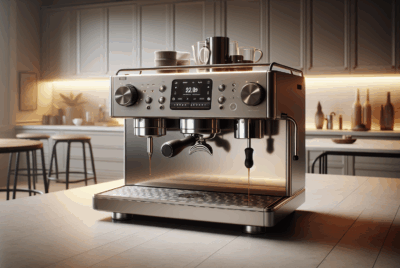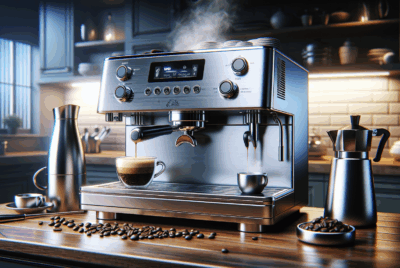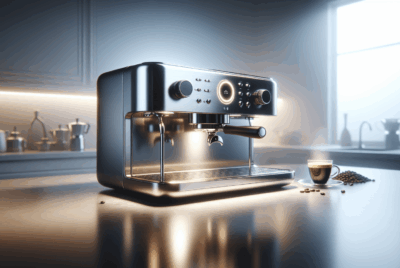Best Water for Espresso: Enhancing Flavor and Quality
As an Amazon Associate, I earn from qualifying purchases, at no additional cost to you. Disclaimer
When I think about making the perfect espresso, the water used is just as important as the coffee beans.
The best water for espresso is purified, with mineral content balanced for flavor clarity and machine health.
Using the wrong water can make the espresso taste bad and even damage the machine over time.

Espresso brings out strong flavors, so I find that water with too many minerals, especially calcium and magnesium, can make it taste off.
On the other hand, using distilled water isn’t good either because it lacks the minerals that help bring out the rich flavors.
It’s a tricky balance, but worth getting right.
When I choose water for espresso, I’m careful to look for good quality.
The aim is to let the coffee’s true flavors shine through.
Every time I make an espresso using the right water, the drink is consistently great.
Understanding Espresso and Its Relation to Water
Water is a key ingredient when making espresso. It impacts flavor, extraction quality, and crema formation. Here’s how water plays a role in crafting the perfect shot.
The Basics of Brewing Espresso
I start with finely-ground coffee packed into a portafilter.
The pressure from the espresso machine pushes hot water through the grounds. This process extracts flavors, oils, and other compounds.
The brewing time is crucial. I aim for about 25-30 seconds for a good shot.
Temperature also matters, usually around 195-205°F (90-96°C). Too hot or too cold can ruin the taste.
Specific ratios, like one part coffee to two parts water, help achieve the right balance. Precision is key for consistency.
The Impact of Water on Espresso Flavor
Water affects espresso flavor significantly. Minerals in the water interact with the coffee grounds. This changes the taste and quality of the espresso shot.
Hard water, which has a lot of calcium and magnesium, adds a bitter taste. Soft water, with fewer minerals, might not extract enough flavor.
I pay attention to the Total Dissolved Solids (TDS) in water. This measurement helps in choosing the right balance for extraction.
I aim for water with a TDS level between 75-250 ppm. This range usually provides a good flavor balance.
Neutral pH levels also help in optimizing taste, ensuring no unwanted flavors interfere.
Extraction and Crema Formation
Proper extraction is vital for a rich espresso. When done right, the water pulls essential oils and compounds from the coffee. This enhances the flavor profile and complexity of the espresso.
Over-extraction leads to bitterness, while under-extraction makes it sour. Timing and temperature must be just right.
A key sign of successful extraction is the crema. Crema is the golden, foamy layer that forms on top of the espresso shot. It adds texture and flavor.
The quality of crema can be judged by its thickness, color, and how long it lasts.
Good water quality contributes to forming a stable and appealing crema, adding to the espresso experience.
Water Chemistry and Espresso Quality
The water used for espresso affects the drink’s taste and quality. Understanding water chemistry, including mineral content, hardness, and pH levels, can make a big difference.
Total Dissolved Solids and Mineral Content
Total Dissolved Solids (TDS) measure the combined content of all substances in water. For espresso, water with TDS levels between 75-250 mg/L works best.
Minerals impact how water extracts flavors. Calcium and magnesium are key. They can enhance the flavors or make the espresso taste flat if not balanced.
I find that water with moderate minerals provides the right balance.
Too many minerals cause fun flavors to be masked, while too few make the espresso taste weak.
Hard vs. Soft Water in Espresso Making
Water hardness depends on its mineral content, mainly calcium and magnesium. Hard water has more minerals. I notice that hard water can cause scale buildup in machines, affecting functionality over time.
Soft water, on the other hand, has fewer minerals and can sometimes yield a sour taste.
To get the best espresso, I aim for moderately hard water. It allows for rich extraction without risking machine damage.
PH Levels and Its Effects on Espresso
pH levels indicate water’s acidity or alkalinity. Neutral water, close to a pH of 7, is ideal for espresso.
If water is too acidic (low pH), espresso gets a sharp taste. Alkaline water (high pH) makes it taste dull.
I prefer to use water slightly under 7 pH to achieve a balanced and vibrant espresso. This careful balance helps in unlocking bold flavors without overpowering the drink.
Selecting the Right Water for Espresso Machines

Water quality is vital for great espresso. It affects flavor and machine health. Each water type has unique benefits and drawbacks.
Pros and Cons of Different Water Sources
Tap Water:
It’s convenient and affordable. However, it may contain minerals or chemicals that can affect flavor and harm your machine. Using a home filtration system can improve its quality.
Bottled Water:
Offers consistency in taste and mineral content. Be cautious: some brands have too many minerals, which could cause scale buildup. I prefer natural spring water as it often provides balanced mineral content, enhancing the taste of espresso.
Distilled and Reverse Osmosis Water:
These are almost completely free of minerals. While this prevents scaling, it may lead to flat-tasting espresso. Mixing distilled with tap water can balance mineral levels.
Best Bottled Water for Espresso Machines
Natural Spring Water:
It’s often recommended due to balanced minerals, enhancing flavor. Look for brands low in total dissolved solids (TDS). A TDS range of 75-250 ppm is ideal for espresso machines.
Purified Water:
It’s typically filtered to remove impurities. While not as flavorful as spring water, it’s easier on machines. Brands specify TDS levels, so opt for one with appropriate content for a balance between taste and machine health.
Alkaline Water:
Though marketed for health benefits, its high pH may alter espresso taste and damage machines. It’s best to avoid it when brewing espresso.
Filtration Systems and Water Softeners
Filtration Systems:
A good filtration system removes impurities but retains beneficial minerals. This ensures consistent taste and protects your machine. Choose systems with activated carbon filters for best results.
Water Softeners:
These systems reduce hardness by removing calcium and magnesium. They protect machines from scale buildup.
While they help with durability, some systems may remove ions needed for flavor.
Explore options like Brita filters or reverse osmosis with a remineralization cartridge. These systems offer balance by ensuring proper mineral content in water for espresso.
Water Treatment Methods and Their Impacts

For espresso, water quality can make or break the taste. Different treatment methods affect how water interacts with your espresso machine, influencing both flavor and equipment longevity.
Reverse Osmosis and Distillation
Reverse osmosis and distillation are effective methods for purifying water.
Reverse osmosis water passes through a semi-permeable membrane, removing minerals and impurities. This process provides clean, neutral water that lets espresso flavors shine.
Distillation involves boiling water and collecting the steam, which leaves behind most minerals. Both methods can produce very pure water.
However, water that’s too pure can cause flat-tasting espresso. Sometimes, adding back a mix of minerals helps. This balance is crucial for both flavor and preventing harm to your machine.
Addressing Scale Build-Up and Corrosion
Hard water causes scale build-up, which hinders espresso machine performance. I often see how untreated hard water clogs machine components, increasing maintenance frequency.
Scale build-up impacts heating elements and water flow, reducing lifespan.
Corrosion is another risk, especially with metal parts. Treated water with moderate minerals protects metal surfaces without leaving scale.
Regular descaling helps manage these risks, but relying on the right water from the beginning is better.
Filtration and Softening Solutions
Water filters and softeners are practical choices.
Filtration systems like carbon filters remove chlorine and small particulates. This improves taste and smell without stripping useful minerals.
Meanwhile, water softeners tackle hard water issues by reducing calcium and magnesium.
Soft water prevents scale and eases maintenance. Options like the xfix espresso machine water softener filter integrate directly into machines for convenience.
Choosing the right combination of filtration methods ensures balanced water for quality espresso results.
Optimizing Machine Health and Maintenance

To keep an espresso machine running smoothly, focus on preventing scale buildup, regular maintenance, and choosing the right water filters and softeners. These steps not only safeguard the machine but also enhance the flavors of your espresso.
Preventing Scale Buildup in Espresso Machines
Scale buildup happens when minerals in water, like calcium and magnesium, settle inside the machine. This can affect machine health and the taste of espresso.
Using filtered or softer water can help. With my Casabrews professional espresso machine, I find that a removable water tank makes it easy to manage water quality.
Monitoring water hardness is crucial. You can use water test kits to check the level of minerals.
If minerals are too high, consider using a water softener. This can extend the life of the machine and maintain a 20-bar pressure system.
Keeping these details in check is key to a flavorful espresso and a long-lasting espresso machine.
Regular Maintenance for Optimal Performance
Regular maintenance keeps an espresso machine in prime condition.
I make it a habit to clean the steam wand and milk frother after each use. This prevents milk residue and mineral deposits, which can affect coffee taste and machine performance.
Frequent backflushes with clean water can help clear out any trapped coffee oils.
I also descale the machine monthly to ensure optimal water flow and pressure. For example, my Casabrews machine includes an easy-to-follow guide for descaling.
These regular steps protect the machine from long-term damage and ensure that every cup is brewed to perfection.
Choosing Water Filters and Softeners
Water quality plays a vital role in espresso making.
I evaluate different water filters that help block impurities while preserving essential minerals for flavor. Some filters attach directly to the machine, while others go inside the water tank.
It’s important to choose one that suits your specific espresso machine model.
When minerals are too high, water softeners can be very effective. They reduce the risk of scale buildup significantly.
Consider the compatibility of filters and softeners with your machine. For instance, compatibility with a removable water tank can make maintenance easier.
Remember, the right water filter extends the life of your machine and keeps the espresso tasting great.
Advanced Topics in Water for Espresso
For great espresso, water quality is key. It’s important to look at mineral levels and how they change taste. Exploring how water’s total dissolved solids (TDS) affect espresso can offer helpful tips. Plus, the impact of adding chemicals to water should not be ignored.
Balancing Mineral Content for Flavor Enhancement
By adjusting minerals like calcium and magnesium in water, espresso flavor improves.
Minerals work with coffee’s natural compounds, affecting acidity, sweetness, and bitterness.
Balanced minerals can bring out unique flavors, enhancing each cup. I often find that using water with low sodium helps maintain these flavors without adding unwanted salty notes.
Water testing allows me to check mineral levels accurately.
Using the right balance can create a rich and smooth espresso. I look for minerals that boost flavors without overpowering the coffee.
Understanding Water TDS Range for Espresso
Total dissolved solids (TDS) indicate the concentration of dissolved substances. This includes minerals and trace chemicals that affect espresso’s taste and texture.
The right TDS range, usually between 75-250 parts per million (ppm), is crucial.
If the TDS is too low, the water may leach minerals from metal pipes, affecting taste. A high TDS can overpower the espresso with off-flavors.
Testing your water’s TDS is easy with inexpensive tools.
I find that a balanced TDS helps better extract coffee’s full range of flavors, providing a harmonious cup every time.
Chemical Additives and Their Effects
Some coffee enthusiasts use chemical additives, like Third Wave Water, to fine-tune water composition. These additives usually contain minerals like calcium, magnesium, and sodium in specific ratios.
Understanding trace chemicals in your water is important, as they can interact with coffee during extraction.
I prefer using additives that enhance the espresso’s natural flavors without adding unwanted tastes.
Be aware of how these additives may affect your equipment. Some chemicals might react with elements in espresso machines, causing mineral build-up.
Regular maintenance and careful testing can prevent such issues and keep your machine running smoothly.
Conclusion
When it comes to espresso, water plays a big role. My aim is always to achieve the best espresso flavor. This starts with using pure water. Even a slight difference in water quality can affect the coffee taste.
To brew espresso like a pro, I focus on water with the right balance of minerals. Minerals are key for flavor and making my espresso rich and bold. Too many or too few can throw off the entire drink.
For café-quality espresso at home, I often filter my water. A good filter helps reduce unwanted elements. This ensures each cup has the quality I expect.
Coffee enthusiasts, like myself, know that not just any water will do. By choosing the right water, I get espresso that highlights the beans’ natural flavors. This makes every sip a delight.
Finally, it’s important to remember: great espresso starts with great water. It’s a simple step but makes all the difference in brewing the perfect cup.
Frequently Asked Questions
When making great espresso, choosing the right water plays a key role. It impacts the flavor, machine quality, and overall taste experience.
What type of water contributes to the best flavor in espresso?
I find that the best water for espresso usually is clean, fresh, and has balanced minerals. It shouldn’t have too much chlorine or iron, as these can affect the taste.
Can I use distilled water in my espresso machine?
Using distilled water is not recommended. It lacks the minerals needed for good espresso extraction and can sometimes cause damage to machines by leaching minerals from metal parts.
How does water hardness affect espresso quality?
Water hardness is important. If the water is too hard, it might cause scaling in the machine. If it’s too soft, it won’t extract flavors well. A balanced mineral level is ideal for great espresso.
Is third wave water enhancers a good choice for making espresso?
Third wave water enhancers can be a convenient option. They are designed to have balanced minerals, which can improve flavor and protect the machine from scaling.
What are the risks of using tap water in espresso machines?
Using tap water may lead to scaling if it’s too hard. It can also contain impurities like chlorine, which can affect taste and might harm the machine over time.
Are there specific bottled waters recommended for use in espresso machines?
Some people recommend using bottled water with a balanced mineral content.
Brands like Crystal Geyser and Volvic are often suggested, but it’s important to check the label for mineral balance.



